Cuprins
- 1 A Taste of Romania – Exploring a Rich Culinary Heritage
- 2 Staple Ingredients: The Heart of Romanian Flavors
- 3 A Culinary Exploration: Must-Try Iconic Romanian Dishes
- 4 The Flavors of a Place: Experiencing Romanian Food Culture
- 5 Street Food Adventures: Savoring Everyday Romanian Flavors
- 6 Bringing Romania in Your Kitchen: Sourcing Authentic Ingredients
- 7 Find Freedom: The Authentic Delta Experience at Dolphin Camping
- 8 The Enduring Appeal of Traditional Romanian Food
- 9 Your Romanian Food Questions Answered (FAQ)
- 9.1 Is Romanian food spicy?
- 9.2 What is a typical Romanian meal?
- 9.3 Is Romanian food healthy?
- 9.4 What is a typical Romanian breakfast?
- 9.5 What Romanian drinks should I try?
- 9.6 What do Romanians eat for Christmas and Easter?
- 9.7 How much does a typical meal cost in Romania?
- 9.8 What is telemea cheese?
- 9.9 What is the difference between mămăligă and Italian polenta?
- 9.10 What should I expect if I’m invited to a Romanian home for a meal?
- 9.11 Are there good vegetarian options in Romanian cuisine?
Are you tired of the same old “top 10” lists that barely scratch the surface of a country’s culture? You’re looking for authentic experiences, real flavors, and that feeling of connection you only get from sharing a meal that means something. You want to eat not just what’s popular, but what’s real. So, what if the heart of Romania isn’t found in a fancy restaurant, but in a simple, hearty dish that tells a story?
Key Takeaways
|
This is not another generic food blog post. This is your guide to understanding Romanian cuisine through its most honest dishes. You’ll learn to recognize the core meals that define our tables, from the universally loved sarmale to the specific taste of a Danube Delta fish brine. Forget the tourist traps; you’re about to discover the flavors that locals crave and the exact places that offer a genuine escape, like a quiet campsite such as Dolphin Camping in the heart of the wild Danube Delta.
- A Taste of Romania – Exploring a Rich Culinary Heritage
- Staple Ingredients: The Heart of Romanian Flavors
- A Culinary Exploration: Must-Try Iconic Romanian Dishes
- The Flavors of a Place: Experiencing Romanian Food Culture
- Street Food Adventures: Savoring Everyday Romanian Flavors
- Bringing Romania in Your Kitchen: Sourcing Authentic Ingredients
- Find Freedom: The Authentic Delta Experience at Dolphin Camping
- The Enduring Appeal of Traditional Romanian Food
- Your Romanian Food Questions Answered (FAQ)
A Taste of Romania – Exploring a Rich Culinary Heritage
Picture yourself at a rustic table, laden with dishes, perhaps somewhere in the heart of Transylvania. The air is filled with the enticing aromas of simmering stews, freshly baked bread, and the sharp tang of pickled vegetables. More than just sustenance, Romanian cuisine is a vibrant narrative woven from centuries of history, diverse landscapes, and a deep-rooted connection to the land. Whether you’re a seasoned traveler or simply someone who appreciates good food, exploring authentic Romanian food is an invitation to immerse yourself in a culture where every meal is a celebration of tradition and togetherness.
What makes Romanian cuisine so captivating? It’s the unique tapestry of influences – Roman, Ottoman, Slavic, Hungarian, and Greek – skillfully interwoven with local customs to create a culinary identity that feels both familiar and wonderfully distinct. From the Carpathian Mountains to the Black Sea coast, each region contributes its own unique flavors and specialties. The result is a cuisine that’s hearty, comforting, and always full of delightful surprises.
Join us as we uncover the essential ingredients that define traditional Romanian food, savor iconic dishes that have stood the test of time, and discover sweet treats that provide the perfect ending to any meal. Whether you’re planning a trip to Romania or simply want to bring a taste of the country to your own kitchen, prepare to be inspired, gain practical insights, and develop a deeper appreciation for one of Europe’s most underrated culinary treasures.
Staple Ingredients: The Heart of Romanian Flavors
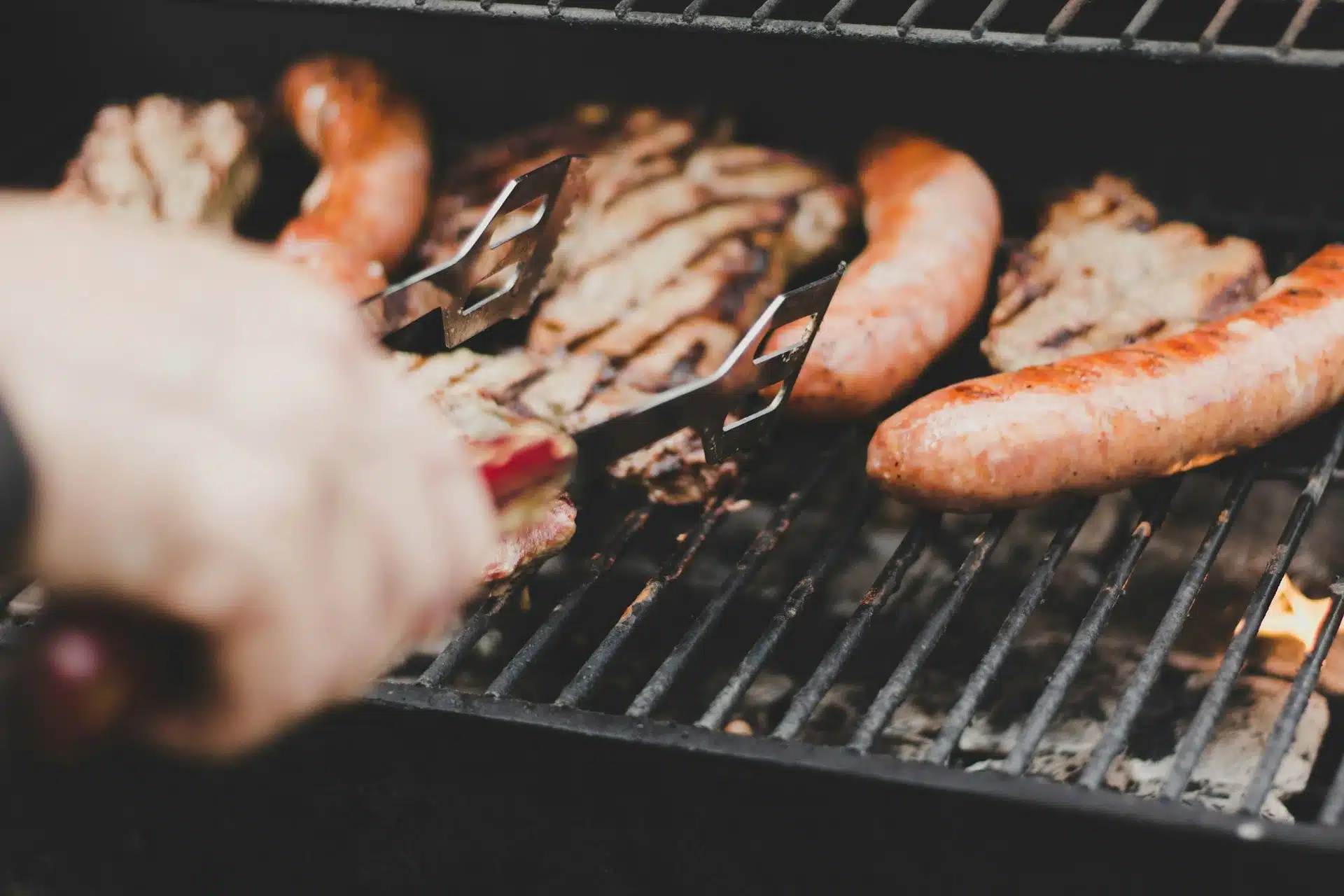
Romanian barbecue with classic meat cuts
At the core of every memorable Romanian meal lies a collection of simple yet impactful ingredients.
Meat
Pork is considered a main source of protein, showcasing its versatility in everything from flavorful sausages to slow-cooked stews. However, the Romanian cuisine offers much more than just pork. Beef, lamb, and poultry each play important roles, particularly in regional specialties.
Dairy
Dairy is another cornerstone. Imagine creamy smântână (sour cream) generously topping soups, tangy sheep’s milk cheeses like telemea and brânză de burduf, and fresh yogurt that’s equally enjoyable for breakfast and dessert. Cornmeal, transformed into the iconic mămăligă (Romanian polenta), is a comforting and filling side dish.
Vegetables
Vegetables—especially cabbage, beans, onions, garlic, and peppers—add color and depth to every plate. Pickled vegetables, or murături, are a must-have at any meal, their sharpness providing a counterpoint to the richness of meats and cheeses. Herbs like dill, parsley, and thyme are used thoughtfully, enhancing rather than overpowering the natural flavors.
One ingredient that truly sets Romanian food apart is borș, a fermented wheat bran liquid that lends its signature tang to many soups. It’s a taste of history, a testament to the ingenuity of Romanian cooks.
A Culinary Exploration: Must-Try Iconic Romanian Dishes
Romania, a land steeped in history and vibrant culture, offers a culinary landscape as diverse and captivating as its storied past. From the hearty comfort of its traditional stews to the delicate sweetness of its pastries, Romanian cuisine is a testament to the country’s rich heritage and the influences of its neighbors.
Hearty Soups and Stews: The Essence of Romanian Comfort
Romanian meals often begin with a steaming bowl of soup or stew, each a celebration of the country’s love for rich, comforting flavors. For a less adventurous option, ciorbă de perișoare (meatball soup) features tender pork meatballs in a tangy vegetable broth, brightened with fresh herbs.
Stews like tochitură—a hearty mix of pork, sausages, and sometimes offal, simmered in a tomato-based sauce—are the ultimate comfort food, especially when served with a generous helping of mămăligă and a fried egg on top. Vegetarian options abound as well, with iahnie de fasole (bean stew) offering a smoky, satisfying alternative often paired with pickled vegetables for a burst of flavor.
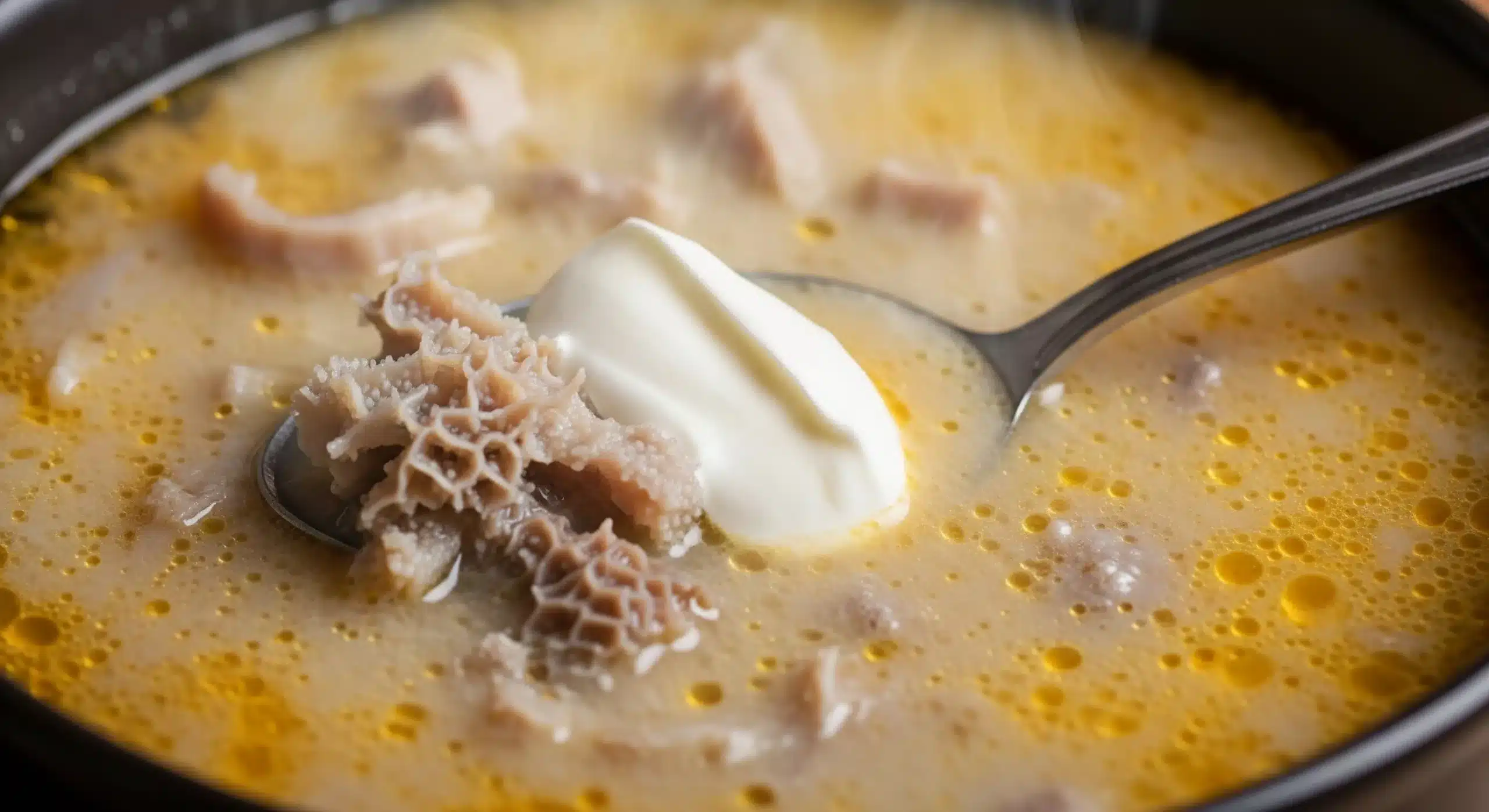
A close-up of Ciorbă de burtă with sour cream.
Don’t be intimidated by the tripe in ciorbă de burtă. When prepared correctly, it’s incredibly tender and adds a unique depth of flavor to the soup. This is a national favorite, its creamy, garlicky broth soured with borș and enriched with a swirl of sour cream. If you’re hesitant, start with a small portion and see if you enjoy it. You might be surprised!
Appetizers and Starters: A Warm Romanian Welcome
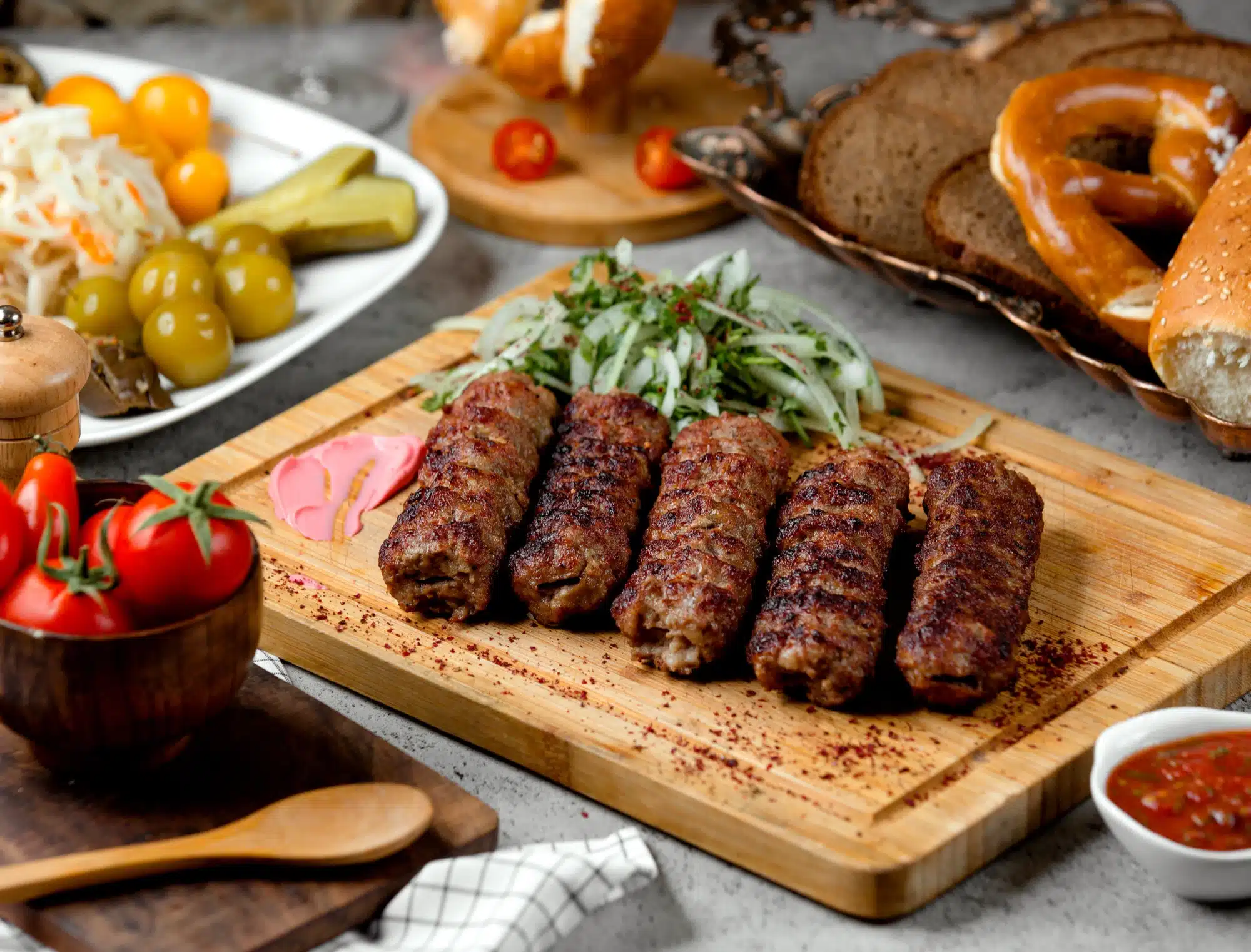
Cutting board with well cooked Romanian mici
No Romanian meal is complete without a delightful selection of Romanian appetizers. Zacuscă, a smoky vegetable spread made from roasted eggplant and peppers, is a staple at every table, particularly in autumn when the harvest is plentiful. Salată de vinete (eggplant salad) and salată de icre (fish roe dip) showcase the country’s love for simple, honest flavors, while platters of local cheeses and cured meats invite guests to relax and enjoy.
For a more indulgent treat, cașcaval pane (fried cheese) offers a crispy, gooey bite that’s hard to resist. These starters aren’t just about whetting the appetite; they celebrate Romania’s agricultural bounty and extend a warm welcome to every guest.
Salată de vinete is often made with mayonnaise, but you can lighten it up by using Greek yogurt instead. This will give it a tangy flavor and reduce the fat content. Serve these Romanian appetizers with crusty bread or crackers for dipping.
No visit to a Romanian street festival or backyard barbecue is complete until you follow the smoky, savory scent leading to a grill full of mici. Pronounced ‘meech,’ these are caseless sausages made from a rich blend of ground meats, traditionally beef and pork, packed with garlic and a signature mix of spices. The magic happens on the grill, where they become juicy on the inside and perfectly charred on the outside. You eat them hot, straight off the fire, with a generous swipe of sharp mustard, a slice of fresh bread, and, ideally, a cold beer in hand. They aren’t fancy, but they are the heart of Romanian outdoor gatherings—simple, deeply satisfying, and meant to be shared.
After exploring the delightful world of Romanian appetizers, prepare to delve into the heart of the feast: the main courses that define Romanian culinary tradition.
The Romanian National Dish: Sarmale
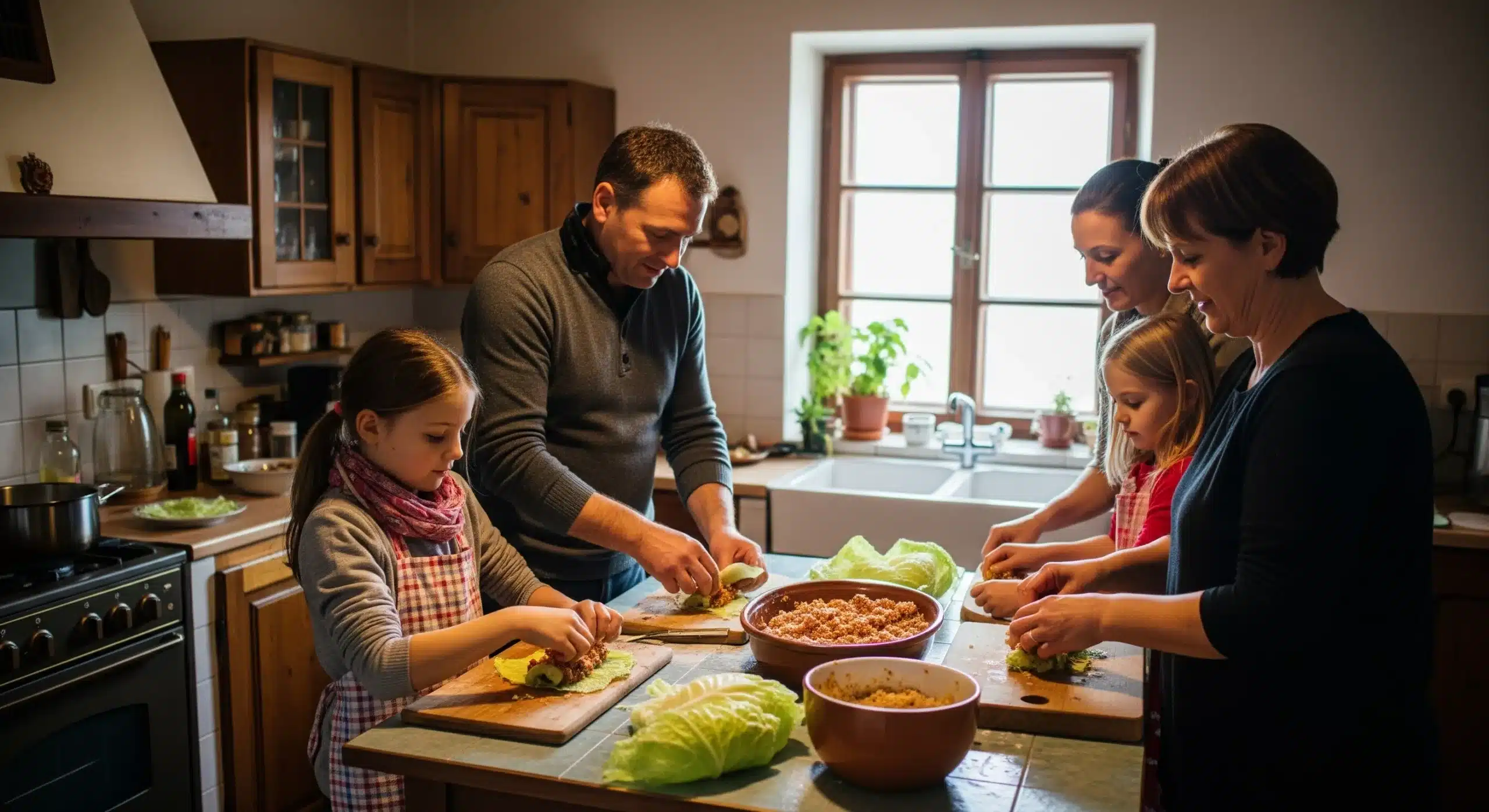
A Romanian family in the kitchen making sarmale
When one thinks of Romanian cuisine, sarmale invariably comes to mind. These aren’t just cabbage rolls; they’re a symbol of Romanian hospitality, tradition, and family gatherings. The preparation itself is an event, often involving multiple generations sharing stories and techniques passed down through time.
The key to exceptional sarmale lies in the balance of flavors: the slight tang of the pickled cabbage, the savory richness of the pork and rice filling, and the subtle blend of herbs and spices. Slow cooking is essential, allowing the flavors to meld and deepen, creating a dish that’s both comforting and complex.
Regional variations abound, with some recipes incorporating smoked meats, others adding a touch of tomato paste, and still others using different types of cabbage. But regardless of the specific ingredients, sarmale always evoke a sense of warmth and belonging.
After savoring the hearty main courses, it’s time to indulge in the sweet side of Romanian cuisine. Let’s explore the delightful world of Romanian desserts.
Having enjoyed the substantial main courses, it is now time to take delight in the sweeter aspects of Romanian gastronomy.
Sweet Endings: Irresistible Romanian Desserts

Romanian Papanasi with fruit jam
Romanian desserts offer the perfect sweet finale to any meal, providing a taste of tradition. Papanasi, fried cheese doughnuts topped with sour cream and fruit jam, are a decadent treat cherished throughout the country. Papanasi are best enjoyed warm, right after they’ve been fried. The combination of the crispy doughnut, creamy sour cream, and sweet jam is simply divine. If you’re feeling adventurous, try making your own jam using local fruits.
Cozonac, a rich, yeasted sweet bread filled with walnuts, cocoa, or Turkish delight, is a holiday staple that brings families together.
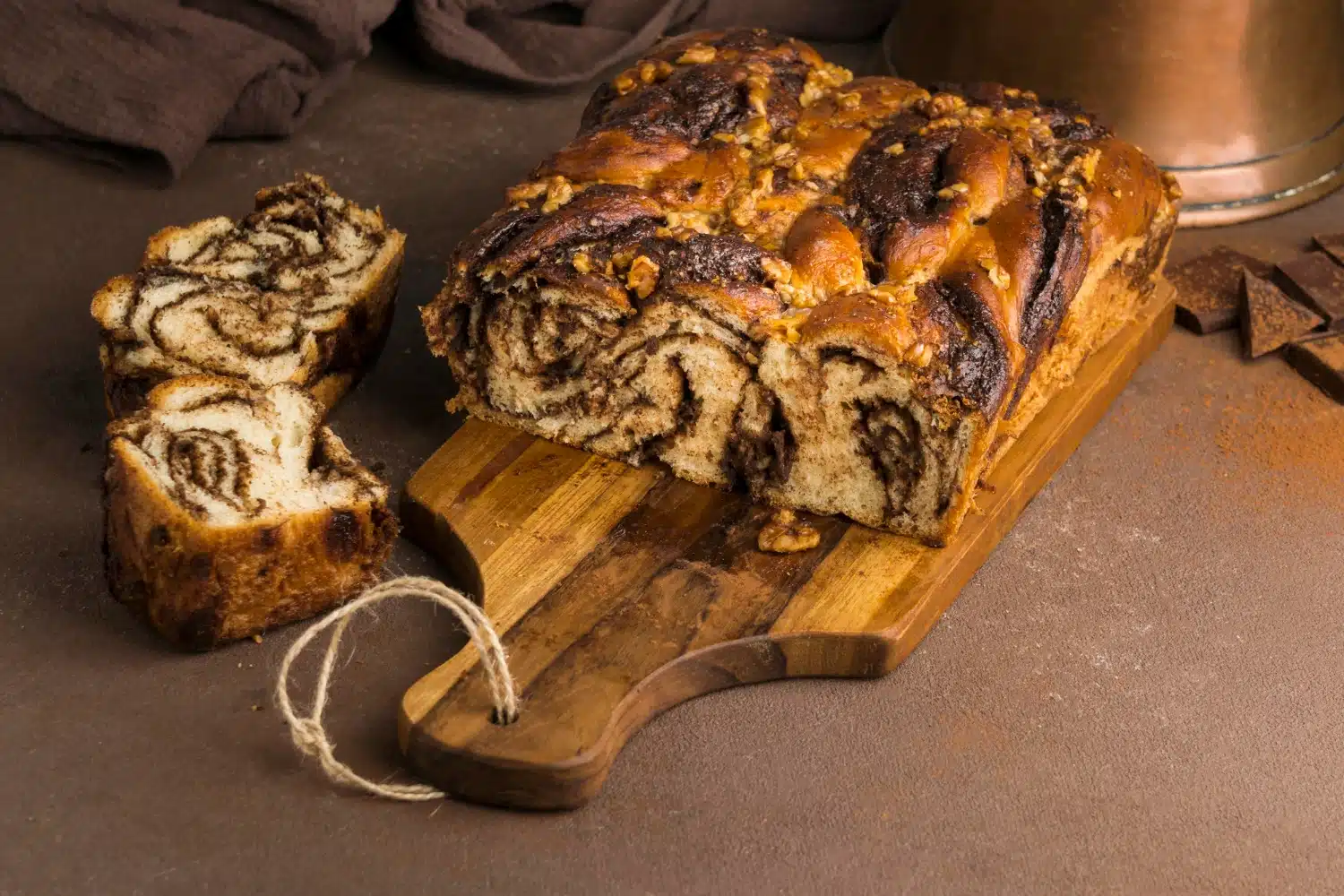
Cozonac cut into two big chunks on a cutting board
Other favorites include plăcinte (sweet or savory pies), salam de biscuiți (biscuit salami), and gogoși (Romanian doughnuts), each a testament to the creativity of Romanian bakers. These desserts may be simple, but they’re made with love, and that’s what makes them unforgettable.
The Flavors of a Place: Experiencing Romanian Food Culture
Beyond mere sustenance, food serves as a vibrant gateway to understanding a culture’s heart and soul. In Romania, this is particularly true. Join us as we embark on a delectable journey to uncover a culinary exploration into the Romanian street food and more:
Street Food Adventures: Savoring Everyday Romanian Flavors
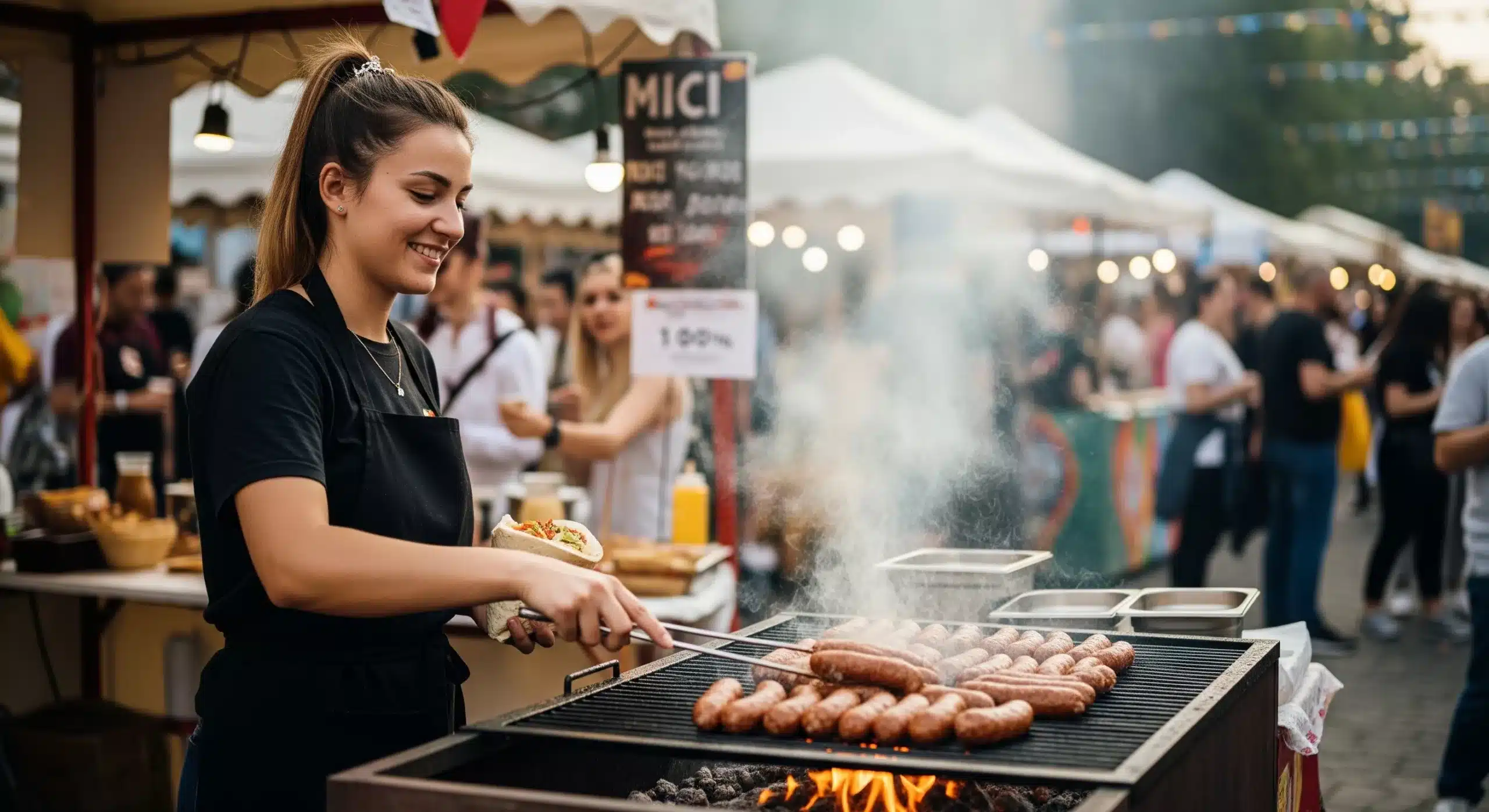
Woman grills and sells mici as street food
To truly appreciate popular Romanian dishes, you have to explore the streets. Covrigi (Romanian pretzels) are a ubiquitous snack, their chewy, salty goodness providing the perfect pick-me-up any time of day. Plăcinte and shaorma (kebab wraps) offer quick, satisfying meals on the go, while fried fish in coastal towns brings the taste of the Black Sea directly to your hands.
Street food is more than just convenience—it’s about community. Whether you’re grabbing mici hot off the grill at a festival or sharing a bag of covrigi with friends, these everyday eats offer a glimpse into the rhythms of Romanian life.
Look for street vendors who are popular with locals. This is usually a good sign that the food is fresh and delicious. Don’t be afraid to try something new – you might discover your new favorite snack!
Beyond the bustling streets, Romania’s diverse regions offer unique culinary experiences. Let’s embark on a delicious map of Romania and explore its regional specialties.
You’ve imagined the freedom of exploring Romania’s raw, honest flavors. That same spirit of freedom calls you to an escape under the stars, where your pet can roam by your side and the wilderness is your neighbor. Discover what wild camping in Romania truly means at a place naturally isolated from the world, yet equipped with everything you need!
Regional Specialties: A Delicious Map of Romania
Romania’s diverse regions each contribute unique flavors to the culinary landscape. In Transylvania, Austro-Hungarian influences are evident in dishes like varză a la Cluj and balmoș (creamy polenta with cheese). Moldova is known for its hearty stews and pies.
Oltenia’s spicy saramură de crap (carp in brine) delivers a fiery kick. It isn’t just another fish recipe; it’s an entire experience. Imagine a whole carp, grilled over open flames until its skin is perfectly charred and smoky, then plunged into a sizzling brine of hot water, tomatoes, fiery peppers, and garlic. Served with a generous helping of polenta (mămăligă) to soak up the intensely savory broth, it’s a dish that’s both rustic and unforgettable. While you might find this specialty elsewhere, to eat the most authentic and flavorful fish dishes Romania has to offer, you simply have to go to the source—a visit to the Danube Delta is an absolute must.
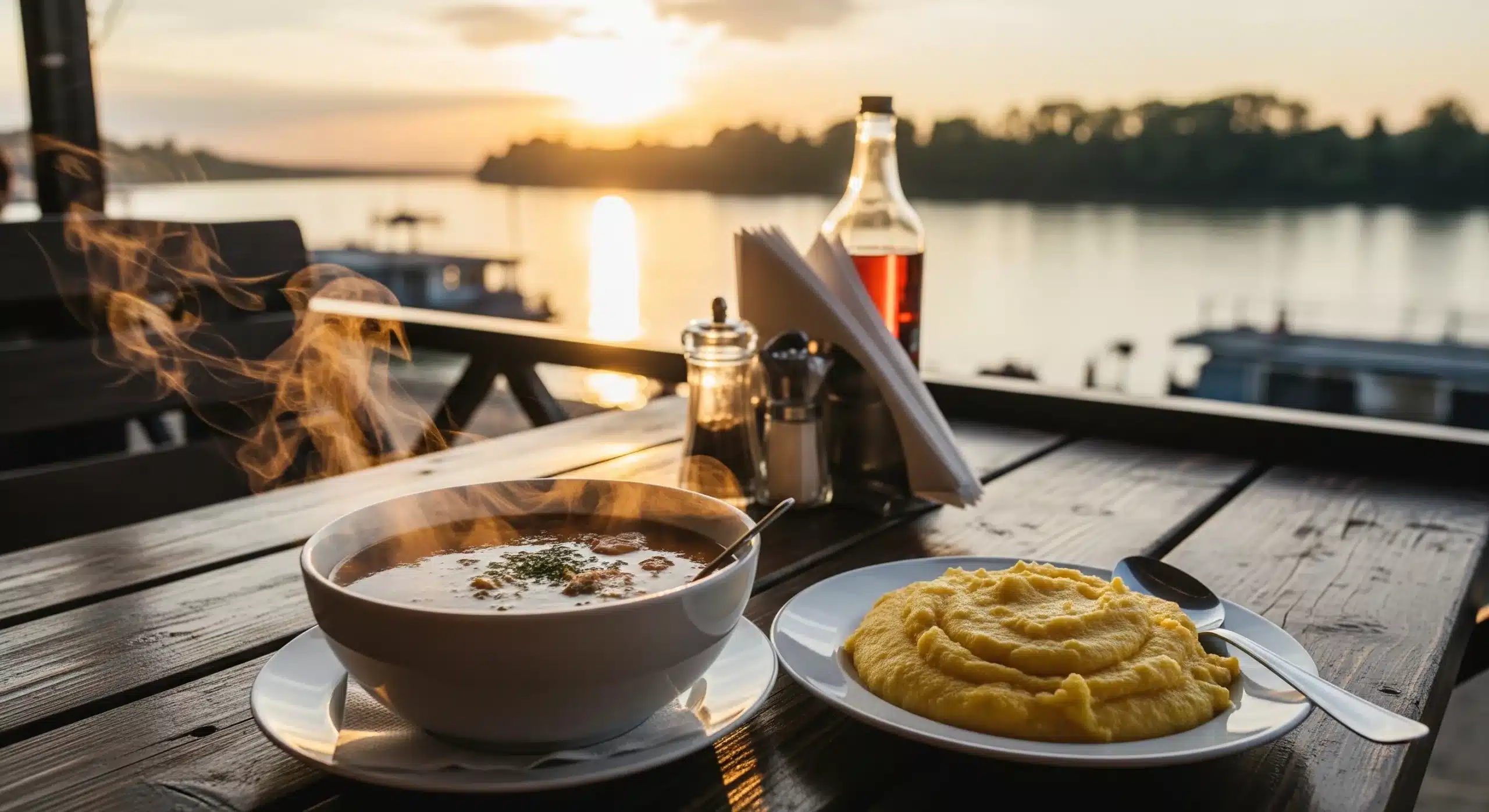
A Danube Delta terrace table with saramura de crap and polenta
Along the Black Sea, fresh fish and seafood take center stage, reflecting the region’s maritime heritage.
Exploring these regional specialties is like embarking on a culinary road trip across Romania—each stop offering something new, surprising, and utterly delicious.
When traveling through Romania, be sure to ask locals for their recommendations on regional specialties. They’ll be happy to share their favorite dishes and tell you where to find the best versions.
Consider taking a cooking class focused on regional cuisine. This is a great way to learn about the ingredients and techniques used in different parts of Romania.
As we explore the diverse regions, it’s clear that Romanian cuisine is deeply rooted in comfort food and tradition. Let’s delve into the dishes that truly warm the soul: Romanian comfort food classics.
You now know that the Danube Delta offers a unique taste found nowhere else, a place where the river meets the sea. This incredible region, accessible only by boat, holds countless more secrets waiting to be uncovered, from its unique wildlife to its hidden channels. Read more about the curiosities and general information about the Danube Delta to fully understand the magic of this one-of-a-kind destination!
Comfort Food Classics: Dishes That Warm the Soul

Top view cooked Romanian peppers with ground meat
At its heart, Romanian comfort food embodies warmth, nostalgia, and the simple pleasure of a home-cooked meal. Mămăligă cu brânză și smântână (polenta with cheese and sour cream) is the ultimate comfort food dish, its creamy, salty, tangy flavors evoking memories of family gatherings and cozy evenings. Ardei umpluți (stuffed peppers) are other beloved favorites, their familiar flavors offering a sense of security and belonging.
These dishes are more than just food—they’re a connection to the past, a reminder that no matter where you are, you can always find solace in a bowl of soup or a plate of polenta.
Comfort food is often about simplicity and using readily available ingredients. Don’t be afraid to adapt recipes to your own taste and preferences. The most important thing is to create a dish that brings you joy and comfort.
Bringing Romania in Your Kitchen: Sourcing Authentic Ingredients
Want to recreate authentic Romanian food in your own kitchen? Start by finding quality ingredients. Look for Eastern European markets that carry sheep’s milk cheese, smoked meats, and cornmeal. Don’t be afraid to try pickling your own vegetables or making simple mămăligă. It’s easier than you might think and brings a genuine taste of Romania to your table.
Consider growing your own herbs, such as dill and parsley, which are frequently used in Romanian cooking. Even a small herb garden can provide a fresh supply of these essential flavor enhancers. If you can’t find borș, experiment with other souring agents like lemon juice or sauerkraut juice, though the flavor profile will be slightly different.
Also, remember that the quality of your ingredients matters. Opt for locally sourced produce and high-quality meats whenever possible. The better the ingredients, the more authentic and flavorful your Romanian dishes will be.
Find Freedom: The Authentic Delta Experience at Dolphin Camping
That yearning for something real—for a genuine connection with nature and a simpler way of living—is answered in the Danube Delta. This is a place for anyone who feels nostalgic for the raw spirit of Vama Veche, before it traded its wild soul for concrete and commercialism.
At Dolphin Camping, the experience is built around the feeling of freedom. You’ll find 55 minimalist cottages, equipped with everything you need and nothing more. The real luxury isn’t inside the cottages, but outside of them: more fresh air, more quiet, and more nature ready to embrace you.
This isn’t just a place to sleep; it’s a place to live freely. The days are for open-air experiences. You can watch a movie under the stars at the outdoor cinema, start a friendly game of volleyball on sand, or simply find a spot at our terrace to witness those sunsets. It doesn’t matter if you stay for two nights or twenty-two; the feeling will be the same: pure, simple, and good.
Whether you’re looking for a breakfast that will fuel your energy for the day or a dinner to end it, we serve traditional and international dishes to fit any taste. The terrace at Dolphin Camping can hold 150 seats, and our open-air bar will allow you to serve your coffee, beer, or long drink in a gorgeous setting.
The Enduring Appeal of Traditional Romanian Food

Romanian Sarmale in pickled cabbage leaves, polenta and sour cream
Romanian cuisine is more than just a collection of recipes—it’s a living tradition, a bridge connecting past and present, and a celebration of everything that makes this country unique. From the essential ingredients that form the foundation of every dish to the regional specialties that showcase Romania’s diversity, every meal offers an opportunity to connect, to savor, and to discover something new.
Whether you’re enjoying a bowl of ciorbă in a bustling Bucharest eatery, sharing sarmale with family during the holidays, or sampling street food in a lively market, you’re participating in a story that has unfolded for centuries. And with every bite, you’re reminded that the best food isn’t just about taste—it’s about tradition, community, and the simple joy of sharing a meal.
Ready to experience the flavors of Romania firsthand? Visit Dolphin Camping to discover authentic Romanian food, breathtaking nature, and the freedom to live simply in the heart of the Danube Delta.
Your Romanian Food Questions Answered (FAQ)
Curious about Romanian cuisine? This FAQ section answers your most common questions about the flavors, dishes, and culinary traditions of Romania.
Is Romanian food spicy?
Generally, no. Romanian food focuses on savory, rich, and sour flavors. The exception is saramură, which often includes hot peppers, but otherwise, dishes are not typically spicy hot.
What is a typical Romanian meal?
A traditional, full meal consists of three courses: an appetizer (like salată de vinete), a sour soup (ciorbă), and a main course (like sarmale or a meat stew), often served with a side salad of pickled vegetables (murături).
Is Romanian food healthy?
While Romanian cuisine is undeniably delicious and comforting, it’s generally not considered “light” fare. Many dishes are rich in fats, carbohydrates, and animal proteins. Many dishes are rich in fats, carbohydrates, and animal proteins. However, it’s possible to find healthier options by focusing on vegetable-based dishes like ghiveci (vegetable stew) or leaner meats prepared simply. The key is moderation and mindful selection.
What is a typical Romanian breakfast?

Table full of cold and hot Romanian breakfast plates and a cup of coffee
A traditional Romanian breakfast often includes simple, hearty items like eggs (fried, scrambled, or omelet-style), cured meats (such as salami or bacon), cheeses (like telemea or cașcaval), and bread. Merdenea cu brânză (cheese pastries) are also a popular choice for a Romanian breakfast, especially when on the go. Yogurt, particularly a fermented type called “Sana,” is another common breakfast item.
What Romanian drinks should I try?
Beyond țuică (plum brandy), which is often considered the national spirit, Romania offers a variety of beverages worth exploring. Romanian wine is gaining international recognition, with varieties like Fetească Neagră and Fetească Albă being particularly noteworthy. Romanian wine is gaining international recognition, with varieties like Fetească Neagră and Fetească Albă being particularly noteworthy. Romanian beer, such as Ursus and Timișoreana, provides a refreshing accompaniment to many dishes. Vișinată (cherry liqueur) is a sweet and flavorful digestif, often homemade and enjoyed after a meal.
What do Romanians eat for Christmas and Easter?
Christmas dinner is a feast centered around pork, featuring sarmale, cârnați (sausages), piftie (pork aspic), and cozonac. For Easter, the main dishes are made with lamb (roast lamb, drob – a lamb haggis), served alongside painted red eggs and pască, a sweet cheese-filled bread.
How much does a typical meal cost in Romania?
Romania is quite affordable compared to Western Europe. A main course in a mid-range city restaurant can cost between 35-60 RON (€7-€12). A street food meal like mici or a pastry will only cost a few euros.
What is telemea cheese?
Telemea is a traditional Romanian brined cheese, similar in style to feta. It’s typically made from sheep’s milk, but can also be from cow’s or goat’s milk. It ranges from soft and creamy to firm and salty and is used in salads, pastries, or served simply with tomatoes and onions.
What is the difference between mămăligă and Italian polenta?
While both are made from cornmeal, the main difference often lies in texture and usage. Romanian mămăligă is typically cooked to a firmer consistency, so it can be cut like a cake and serve as a bread substitute. Italian polenta is often served softer and creamier.
What should I expect if I’m invited to a Romanian home for a meal?
Expect overwhelming generosity and lots of food. It’s polite to bring a small gift for the hosts, like a bottle of wine, flowers, or a box of chocolates. Be prepared to try everything and accept second helpings—refusing can be seen as a sign you didn’t enjoy the food!
Are there good vegetarian options in Romanian cuisine?
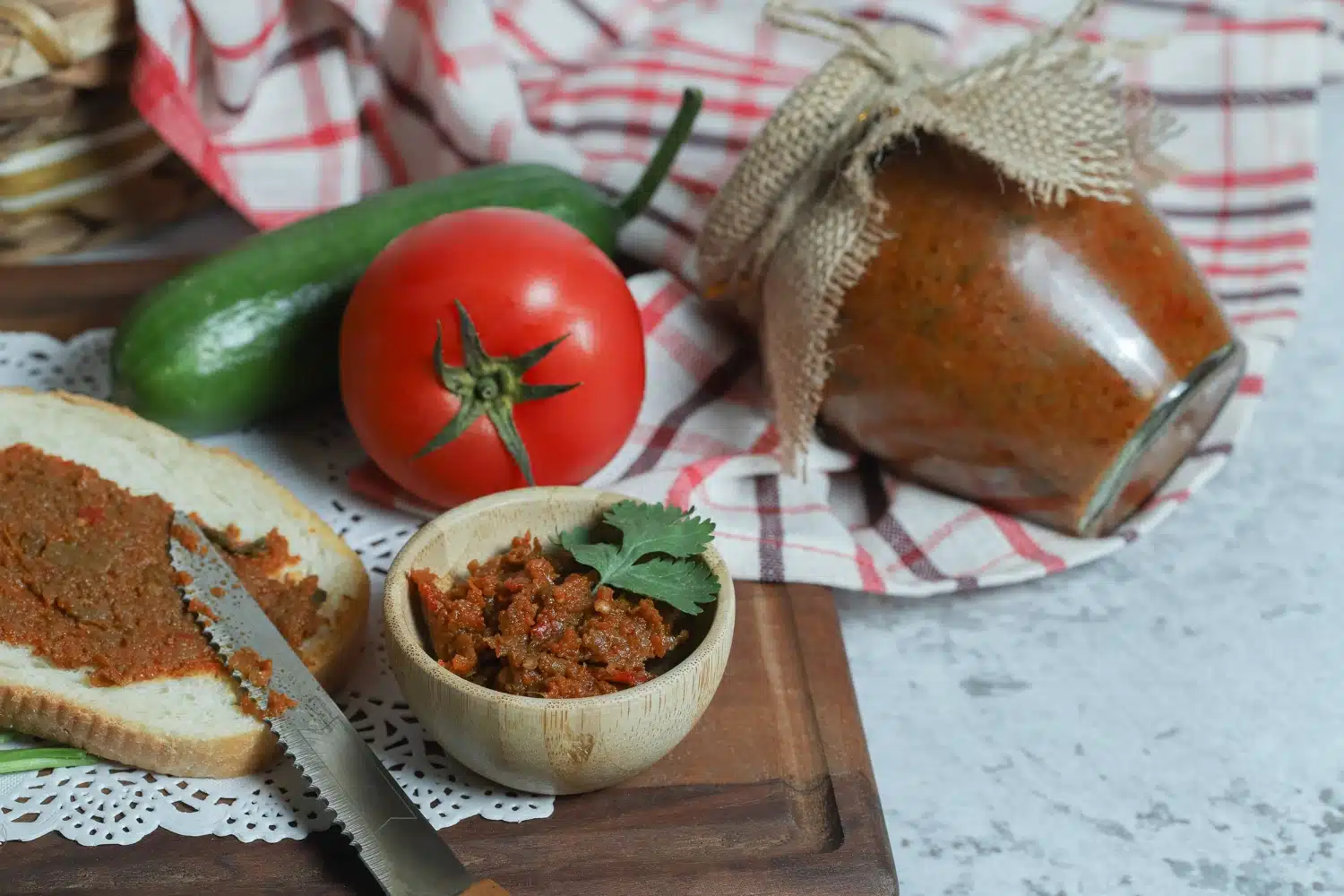
Zacusca spread on a slice of bread
Yes, especially if you look for dishes labeled “de post” (Lent food), which are inherently vegan. Naturally vegetarian choices include zacuscă, salată de vinete, mushroom stews, bean soup, and mămăligă. Just confirm the ingredients, as some recipes may add non-vegan elements.
Photo sources: Unsplash, Freepik, images generated with AI (Gemini)




